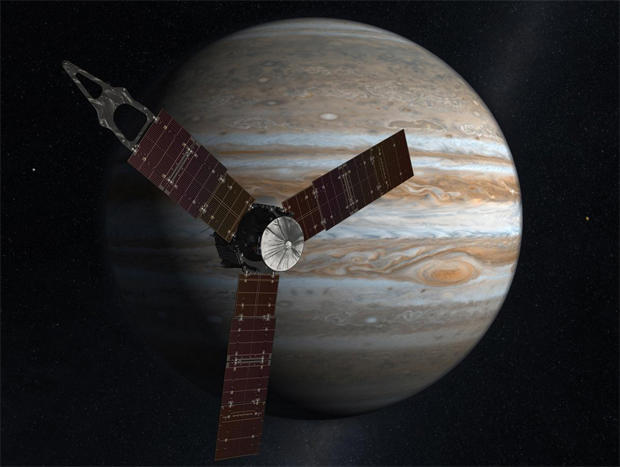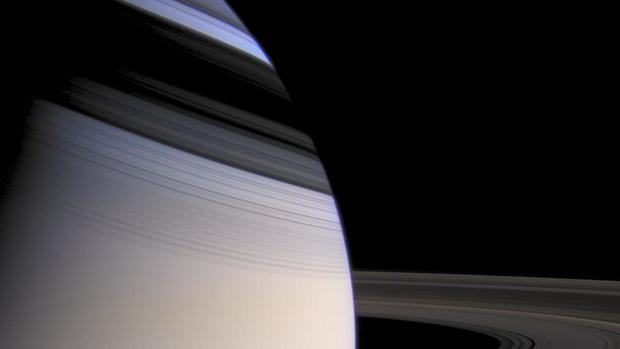NASA's Jupiter probe runs into trouble
NASA’s Juno spacecraft went into protective “safe mode” Tuesday night when an unusual condition of some sort was detected, triggering fault protection software that shut down the probe’s science instruments just before a close flyby of the giant planet Wednesday.
Engineers already were investigating an apparent issue with slow-moving valves in the spacecraft’s main engine pressurization system that prompted them to call off a planned rocket firing during Wednesday’s flyby that would have reduced the probe’s current 53.5-day elliptical orbit to a 14-day orbit for science observations.
With the rocket firing on hold, Juno scientists opted to turn the spacecraft’s second flyby of Jupiter into a science run, activating all of its instruments for data collection during a high-speed pass just 3,000 miles or so above the planet’s cloud tops.
But Tuesday night, Juno went into safe mode and the instruments were shut down.
“On the way in last night, when we were still pretty far away from Jupiter, the spacecraft went into a safe mode,” said Scott Bolton, the principal investigator. “What that means is that the spacecraft, it’s like a smart robot, detected a condition that was not expected.”
“It did exactly what it was supposed to do. ... In this case, it turns off unnecessary subsystems, it points itself, if not already pointed, to point at the sun and go power positive, link up the communications to the Earth and then wait for direction and for the humans back home to evaluate the situation.”
Launched five years ago from Cape Canaveral, Juno traveled a roundabout 1.7 billion miles to reach Jupiter, making a gravity-assist flyby of Earth in October 2013 to pick up enough speed to finally set off after its quarry. It successfully braked into a highly elliptical orbit around the huge planet on July 4.
Juno completed its first orbit in late August and was about to fire its engine during its second close approach when it went into safe mode. One concern from the beginning has been the possible effects of Jupiter’s powerful radiation belts, but Bolton said the heavily shielded Juno encountered the problem well beyond the most energetic regions.
“It’s too early to take a guess as to what caused it,” he said. “It did happen pretty far away from Jupiter, and so my instinct is it may not have been tied to the intense radiation belts that we’re so fearful of. That doesn’t mean there isn’t something else in Jupiter’s environment that may have caused it.”
He said the spacecraft remains safe and in contact with Earth, downlinking stored telemetry to help engineers figure out what caused the initial problem. Meanwhile, troubleshooting continues to better understand the main engine pressurization issue.
Bolton downplayed the long-range impact, saying even if Juno never fired its engine again and remained in its current 53.5-day orbit, the spacecraft would still collect virtually all of its planned science observations.
That’s because the most scientifically interesting regions of each orbit, when Juno is passing within a few thousand miles of Jupiter’s cloud tops, are virtually identical whether the spacecraft takes 53.5 days to complete one elliptical orbit or 14 days.
“Fortunately, the way we designed Juno and the orbit we went into was very flexible,” Bolton said. “It takes about two hours to go from the north pole to the south pole, we’re moving very, very fast. It’s in that time frame where the critical science (is collected). The close-in geometry right around Jupiter is almost identical.”
He said the science team would be able to achieve its goals “even if we stay in a 53-day orbit. Each pass has the same value that a 14-day orbit would have had. We were changing to 14 days primarily because we wanted the science faster. But there was no requirement to do that.”
As for the cumulative effects of radiation over the course of a longer-than-planned mission, Bolton said the length of the orbit is not a factor.
“It doesn’t cause a problem,” he said. “The radiation that Juno gets is only around the closest approach. ... The radiation dose per orbit will be about the same, in fact, it might be a little less. And the duration I don’t think causes an issue. So you can stay in the 53-day orbit and continue to collect essentially almost identical science.”
Still, there’s good reason to resolve the valve problem and shorten the orbit to 14 days. Extending the mission with a longer orbit raises the possibility Juno eventually will be eclipsed by Jupiter, flying into its shadow where its solar arrays cannot generate electricity.
But that will not happen until the middle of 2019, Bolton said.
“We have to go analyze and understand what just happened with the spacecraft safe mode entry, and we also are going to go in and look at the valves and what was going on with the propulsion system,” he said. “Once we figure that out, we’ll decide where to go next. We’re in no rush to make any of these changes.”


